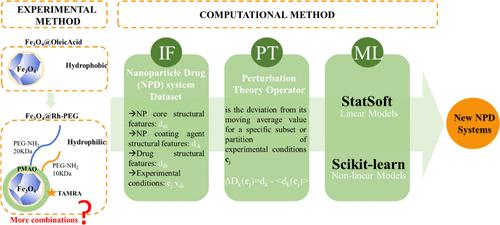Drug Release Nanoparticle System Design: Data Set Compilation and Machine Learning Modeling
IF 8.2
2区 材料科学
Q1 MATERIALS SCIENCE, MULTIDISCIPLINARY
引用次数: 0
Abstract
Magnetic nanoparticles (NPs) are gaining significant interest in the field of biomedical functional nanomaterials because of their distinctive chemical and physical characteristics, particularly in drug delivery and magnetic hyperthermia applications. In this paper, we experimentally synthesized and characterized new Fe3O4-based NPs, functionalizing its surface with a 5-TAMRA cadaverine modified copolymer consisting of PMAO and PEG. Despite these advancements, many combinations of NP cores and coatings remain unexplored. To address this, we created a new data set of NP systems from public sources. Herein, 11 different AI/ML algorithms were used to develop the predictive AI/ML models. The linear discriminant analysis (LDA) and random forest (RF) models showed high values of sensitivity and specificity (>0.9) in training/validation series and 3-fold cross validation, respectively. The AI/ML models are able to predict 14 output properties (CC50 (μM), EC50 (μM), inhibition (%), etc.) for all combinations of 54 different NP cores classes vs. 25 different coats and vs. 41 different cell lines, allowing the short listing of the best results for experimental assays. The results of this work may help to reduce the cost of traditional trial and error procedures.

药物释放纳米颗粒系统设计:数据集编译和机器学习建模
磁性纳米颗粒(NPs)由于其独特的化学和物理特性,特别是在药物输送和磁热疗应用方面,在生物医学功能纳米材料领域获得了极大的兴趣。在本文中,我们实验合成并表征了新的基于fe3o4的NPs,并将其表面功能化为由PMAO和PEG组成的5-TAMRA尸胺改性共聚物。尽管取得了这些进展,但许多NP芯和涂层的组合仍未被探索。为了解决这个问题,我们从公共资源中创建了一个新的NP系统数据集。本文使用了11种不同的AI/ML算法来开发预测AI/ML模型。线性判别分析(LDA)和随机森林(RF)模型在训练/验证系列和3倍交叉验证中分别显示出较高的灵敏度和特异性(>0.9)。AI/ML模型能够预测54种不同NP核心类别与25种不同涂层和41种不同细胞系的所有组合的14种输出特性(CC50 (μM), EC50 (μM),抑制(%)等),从而为实验分析提供最佳结果的简短列表。这项工作的结果可能有助于降低传统试错程序的成本。
本文章由计算机程序翻译,如有差异,请以英文原文为准。
求助全文
约1分钟内获得全文
求助全文
来源期刊

ACS Applied Materials & Interfaces
工程技术-材料科学:综合
CiteScore
16.00
自引率
6.30%
发文量
4978
审稿时长
1.8 months
期刊介绍:
ACS Applied Materials & Interfaces is a leading interdisciplinary journal that brings together chemists, engineers, physicists, and biologists to explore the development and utilization of newly-discovered materials and interfacial processes for specific applications. Our journal has experienced remarkable growth since its establishment in 2009, both in terms of the number of articles published and the impact of the research showcased. We are proud to foster a truly global community, with the majority of published articles originating from outside the United States, reflecting the rapid growth of applied research worldwide.
 求助内容:
求助内容: 应助结果提醒方式:
应助结果提醒方式:


